-
Car Reviews
- Car News
-
Car Comparisons
Latest comparisons
- Chasing Deals
Ford’s seventh-generation Mustang is on the near horizon. We drive the flagship Dark Horse version and find a lot to look forward in the pony car’s newest, fiercest nameplate
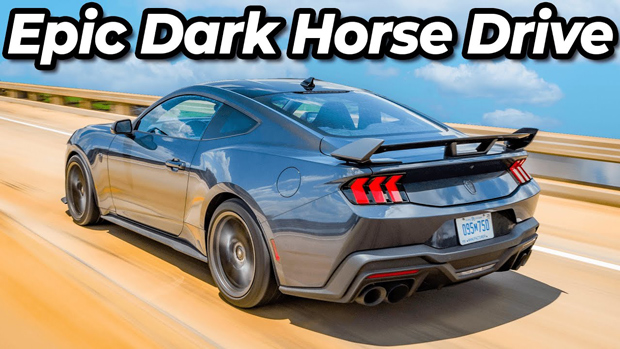
When the Dark Horse bolts down under in Q1 next year, it will be the wildest Mustang ever to hit Ford Australia’s dealership stables.
The high-performance flagship, look set to be the first variant to nudge or breach $100k, was supposed to follow the tamer, regular seventh generation version that should’ve arrived, well, any minute now.
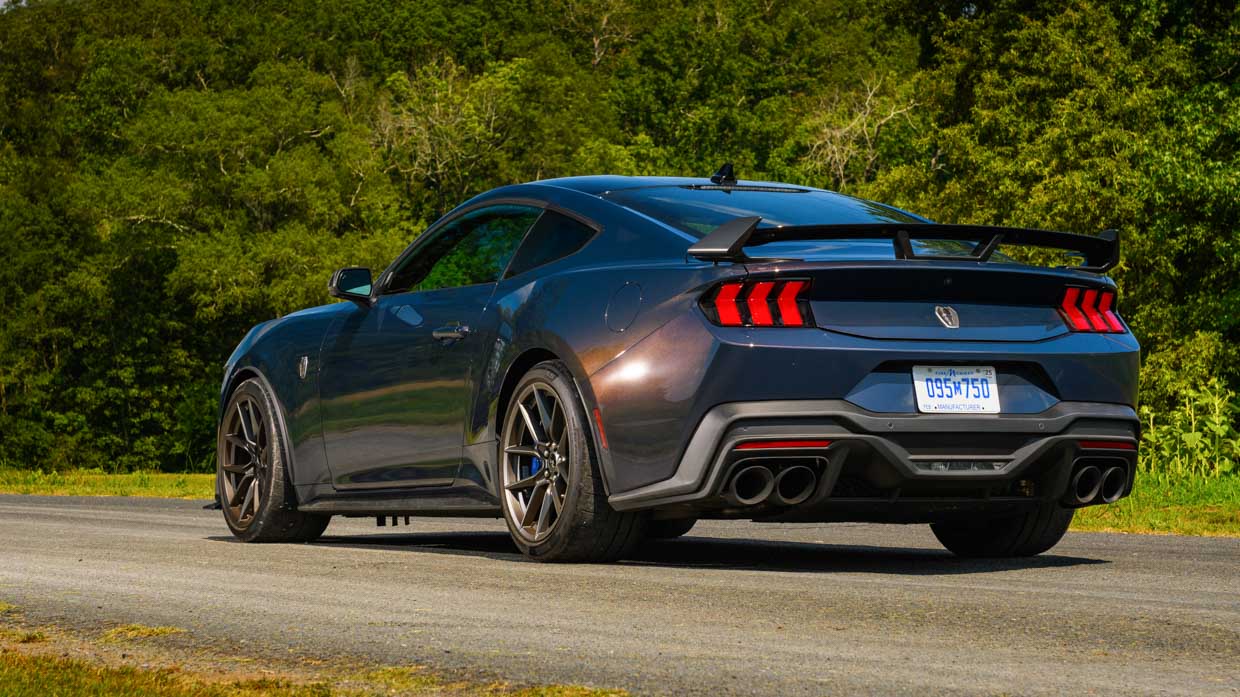
Instead, production delays have pushed back the release of the first new Ford passenger car in a decade, one first detailed a year ago, to a timing that roughly corresponds with its newest, darkest sibling.
It looks likely they’ll be quite a stampede in 2024’s initial months, though Ford might still struggle to keep them wrangled.
That’s because demand has been so strong for the ageing sixth generation – the biggest selling sportscar in Oz by a mile – that Ford Australia was recently forced to pause orders while, of course, encouraging budding tyre-kickers into the new gen.
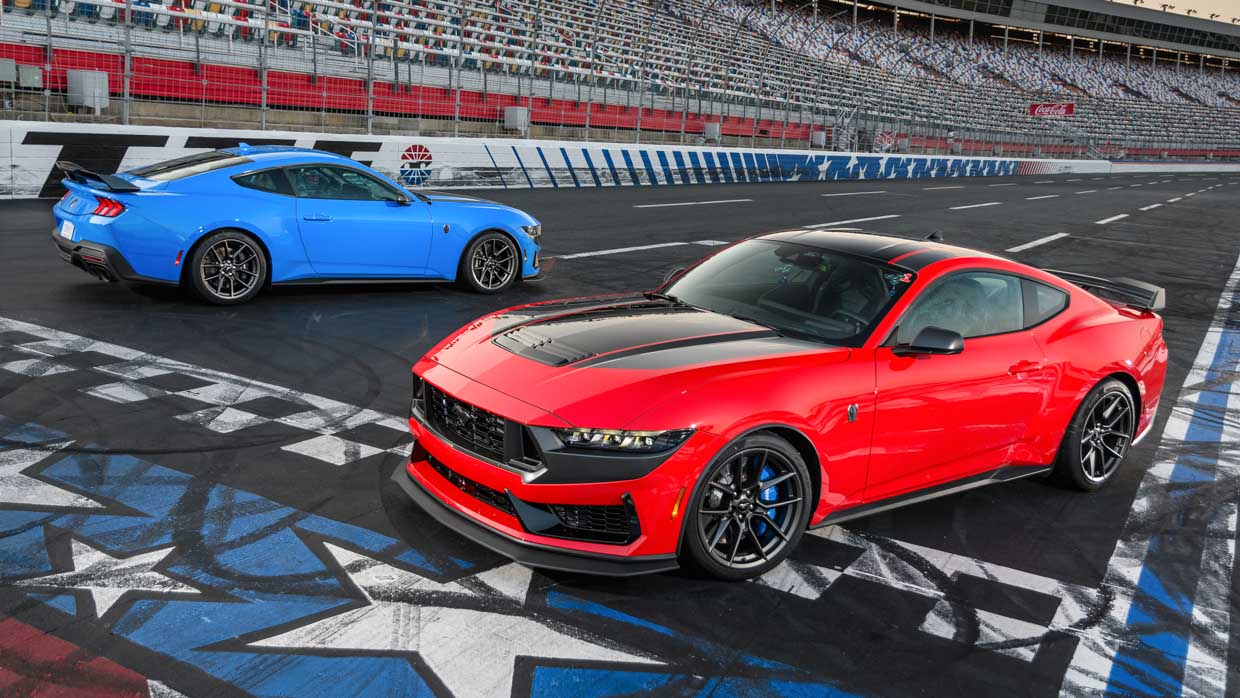
Which is why Chasing Cars finds itself in North Carolina, USA, slinging its leg over the Dark Horse as way of introduction to the entire seventh generation range. Starting from the top? Well, we’re not complaining…
The gen-seven ‘S650’ Mustang gets a sharpened exterior makeover that owes much to the popular outgoing generation and is affine evolution without breaking any moulds. It should look familiar – it’s been running around Aussie motorsport circles for quite some time now.
The return of both 2.3-litre Ecoboost turbo four and five-point-oh V8 options brings unique front-end treatments for each, while both coupe and convertible body style maintain time-honoured tradition with, at least in the US, both regular and pricier Premium grades available across all combinations bar the V8 rag-top (that’s Premium grade only).
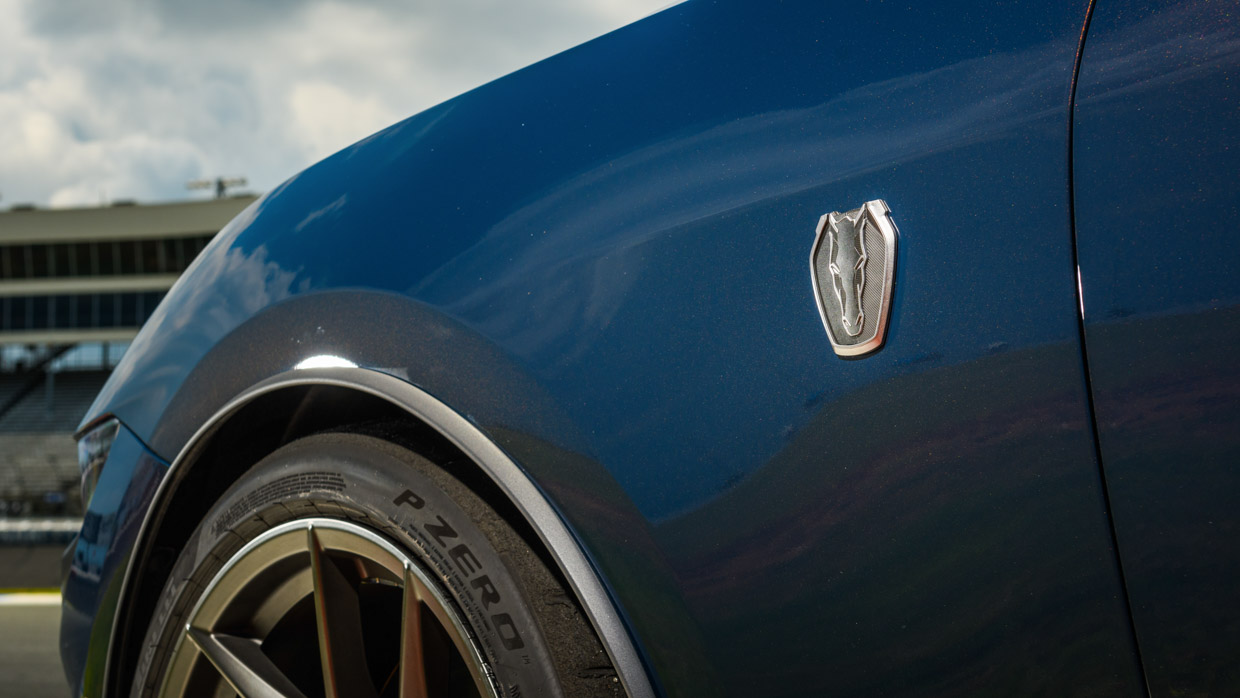
Unsurprisingly, the Dark Horse adopts a bespoke styling theme befitting its name. It gets full LED lighting, its own front and rear fascia styling with a specific front splitter and rear boot spoiler, the latter available with a downforce enhancing Gurney flap in Premium spec, a grille garnish and a cap-less Easy Fill fuel filler.
Most exterior highlights are finished in sinister satin black and Ford has plumbed America’s rich muscle car heritage in offering a trio of different graphic-festooned bonnets with various vinyl and hand-painted motifs.
While the regular US Mustang range fits 17-inch wheels in base Ecoboost trim and offers up to 20-inches in one-inch increments to buyer taste, the Dark Horse exclusively fits 19s.
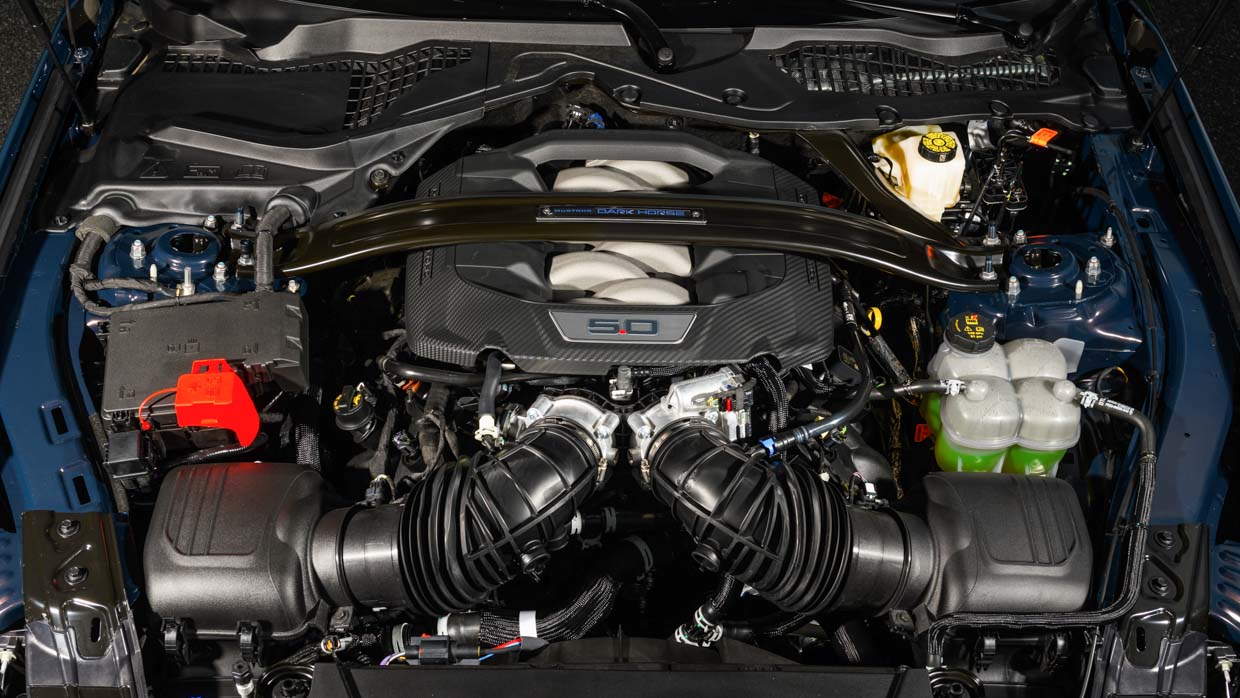
It looks fast and menacing standing still, its aesthetic more closely mirroring the ballistic GT500 of the outgoing generation rather than the retro-throwback Mach 1 or Bullitt editions aimed at diehards and collectors.
And fittingly, perhaps, given that much of the upgrading to the Dark Horse’s engine is lifted from the GT500 parts bin.
The regular GT’s familiar all-alloy Coyote 5.0-litre gets a new dual intake and dual throttle body system as headline updates, the freer top-end breathing largely contributing to a 22kW and 7Nm rise to a new baseline of 358kW and 562Nm.
US owners opting for the variable exhaust system should expect a modest to notable lift to 362kW and 566Nm.
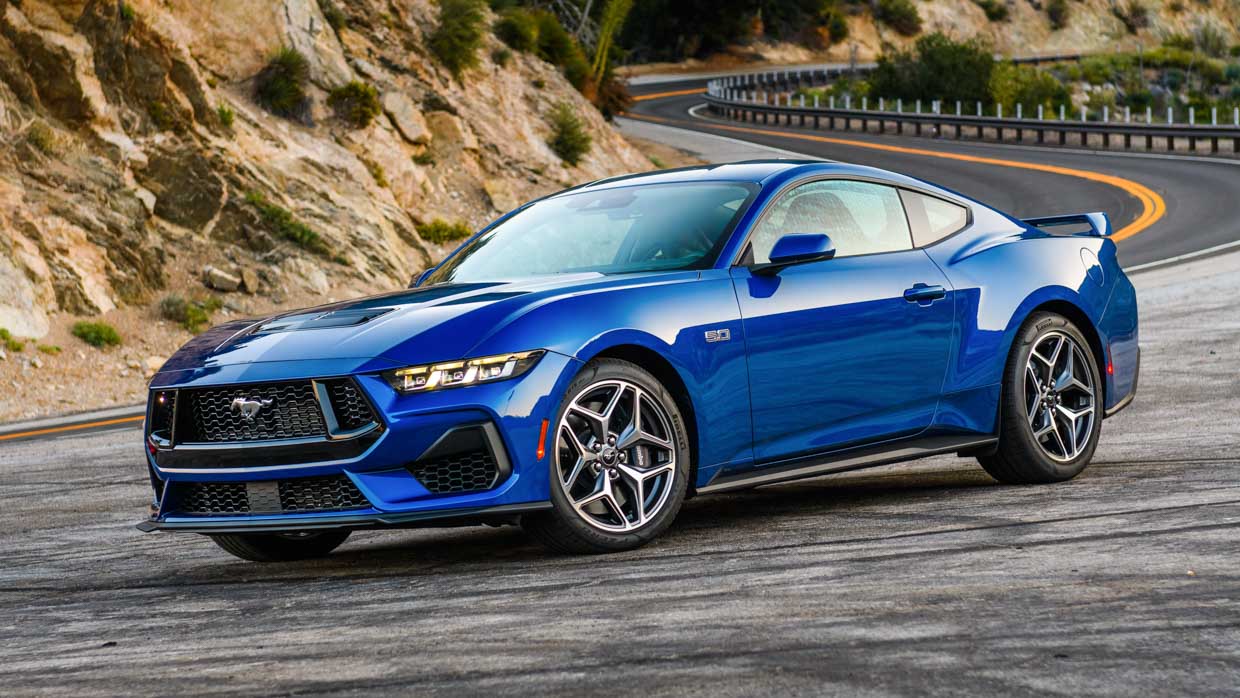
Pictured: the ‘regular’ GT variant in The States
The Dark Horse is quite different. It fits a balanced crankshaft, forged conrods and toughened camshaft spec to help lift redline to a lofty 7500rpm reliably under the expected duress of a variant pitched firmly at the racetrack, though it only yields an added 11kW and no extra torque. Still, 373kW as an old-school 500 horsepower neat has a nice ring to it.
However, neither V8 is nearly as wholesale revamped as the 2.3 Ecoboost, a whole new engine down to different bore and stroke dimensions, now producing 235kW and 474Nm.
The driveline spec matrix is dizzying, but in basic terms everything gets an LSD and a ten-speed automatic option, while only the V8s get a six-speed manual (as standard fitment). The Dark Horse and cost-option Performance Package in other variants adds 3.55:1 (auto) or 3.73:1 (manual) final drive ratios.
But while the regular GT fits a Getrag-sourced manual, the flagship fits a closer-ratio, tougher Tremec unit, complete with an anodised titanium shift knob.
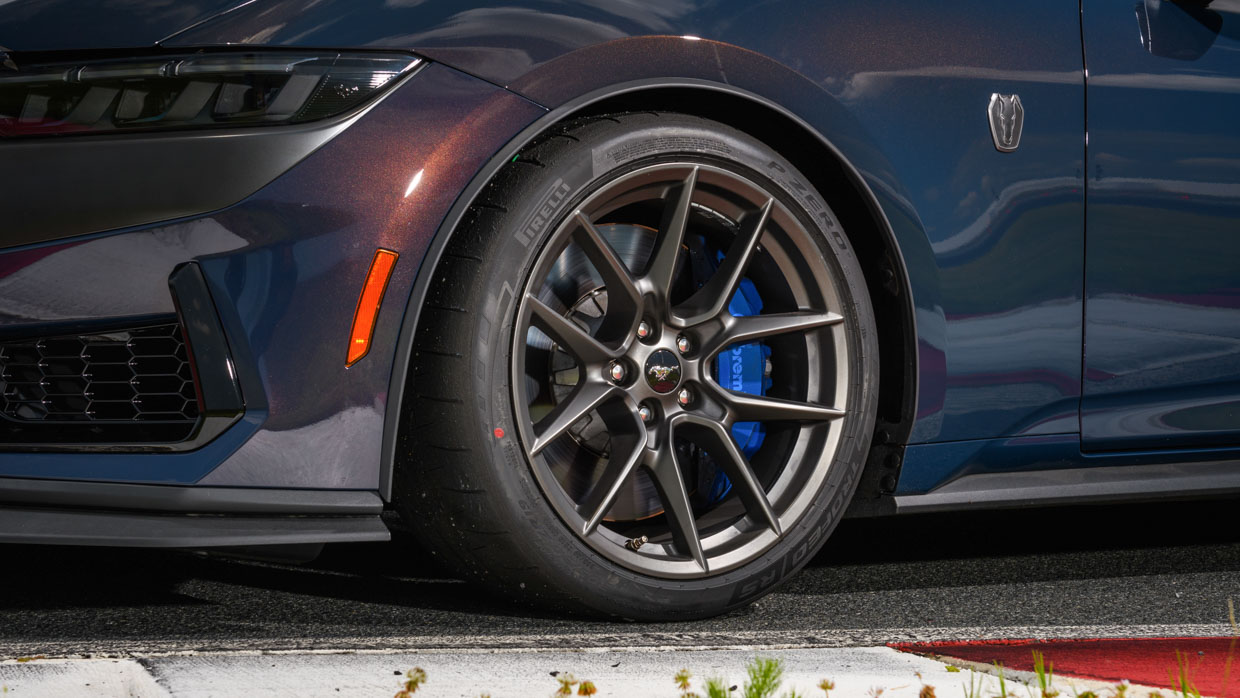
Suspension wise, Mustang is steel sprung with passive dampers unless you’re Perf Pack or Dark Horse territory, which brings MagnaRide adaptive hardware.
Essentially, spring rates get stiffer – though four stages – from to the bottom to the top of the lineup, where an optional Handling Package for Dark Horse essentially fits track suspension and whopping 305mm front and 315mm rubber and brings niceties such as bespoke Pirelli P Zero Trofeo RS tyres and carbon-fibre rims, neither of which are yet confirmed for Australian compliance or release.
It’s a similar story with braking. At its most modest, a four-pot Mustang fits modest two-piston 320mm front anchors, which scales up to four-piston and then mighty six-piston Brembo-branded 390mm jobbies at the range’s top end or if you tick extras boxes on the GTs.
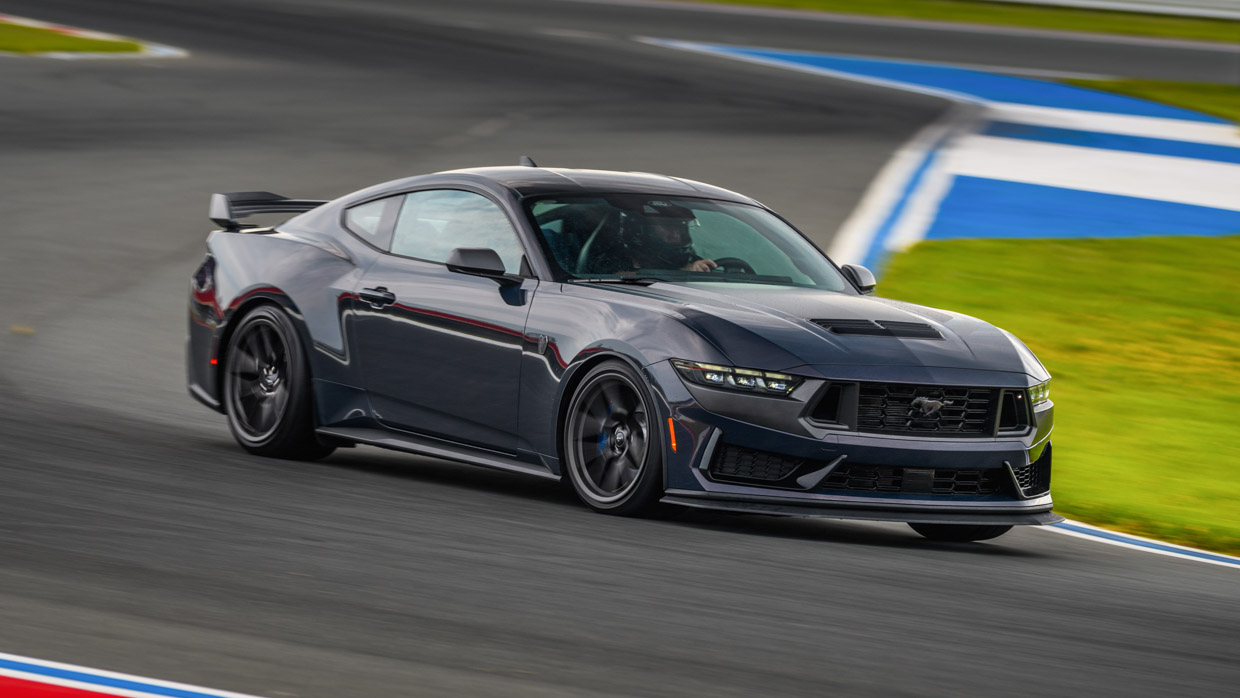
An ideal forum for testing the Dark Horse’s thoroughbred mettle is North Carolina’s Charlotte Motor Raceway, specifically a course within used by the Ford Performance Racing School that takes in a tight infield section as well as half of the massive venue’s oval and one of its high-speed 24-degree banks corners.
I sample two Dark Horse: the first an auto with track-spec Handling Package fitted, the second with the standard chassis sat on regular 255mm/285mm P Zero road rubber – essentially Aussie spec – with the manual transmission.
I discover that each is quite different to the other in character, but both are incredibly fun, very fast and capable, and seems a noticeable dynamic evolution over anything I’ve driven from the outgoing sixth generation.
The Dark Horse is loud. The intoxicating metallic soundtrack is so loud that it’s crystal clear from the far side of the 3.6-kilometre speedway oval uncorked at full noise rounding its steep 24-degree turns one and two. Even entering turn one from the infield, the Dark Horse is north of 200km/h entering the back straight.
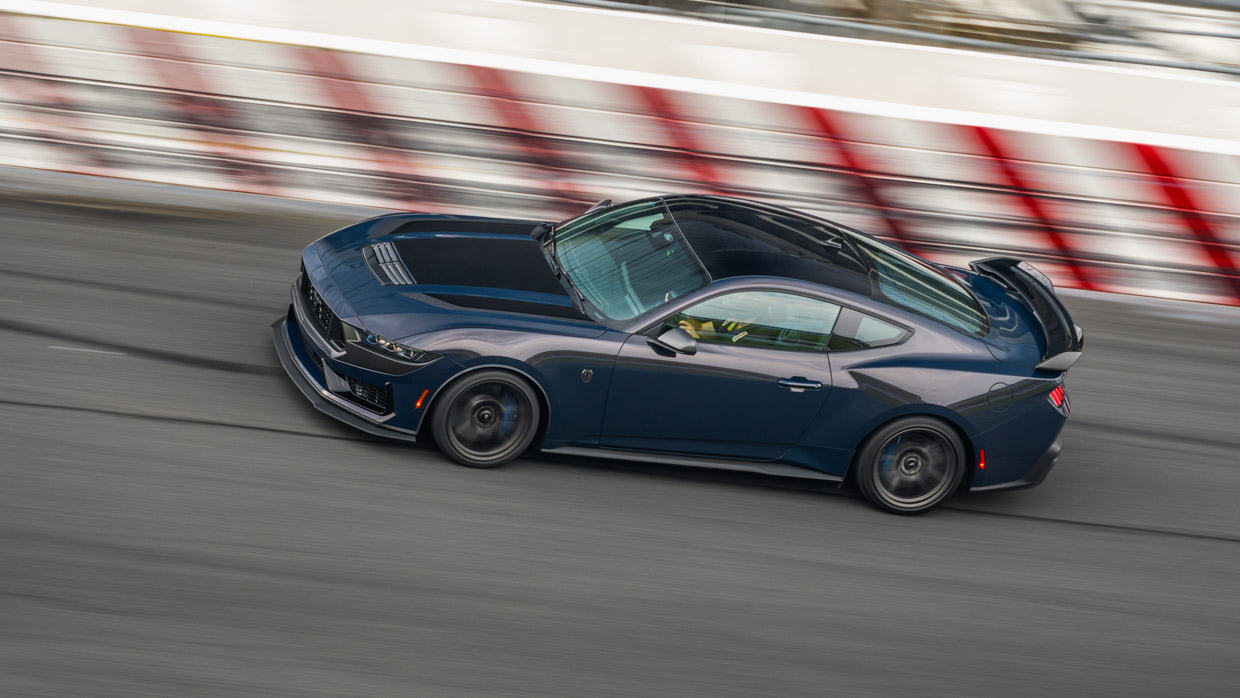
The Handling Package really cements an already ferociously capable package for track and the Trofeo RS rubber is incredibly grippy. Even with big commitment there seems to be a fair measure of stopping and cornering power in reserve.
But it’s the core character that is the real knockout. On a circuit, the chassis is sublimely balanced and quite reactive: according to Ford senior engineers on hand, the MagnaRide damping is highly reactive to the driver’s inputs, providing real-time adjustment at high speed to coerce a neutral and predictable dynamic disposition.
The steering, too, is wonderfully even and linear, with none of the old car’s rubberiness thanks to complete hardware and software rethink.
First impressions are that the Dark Horse is very friendly and confidence inspiring, ideal for novice and expert driver’s alike, with a huge amount of headroom in grip and pace that will come with added commitment behind the wheel.
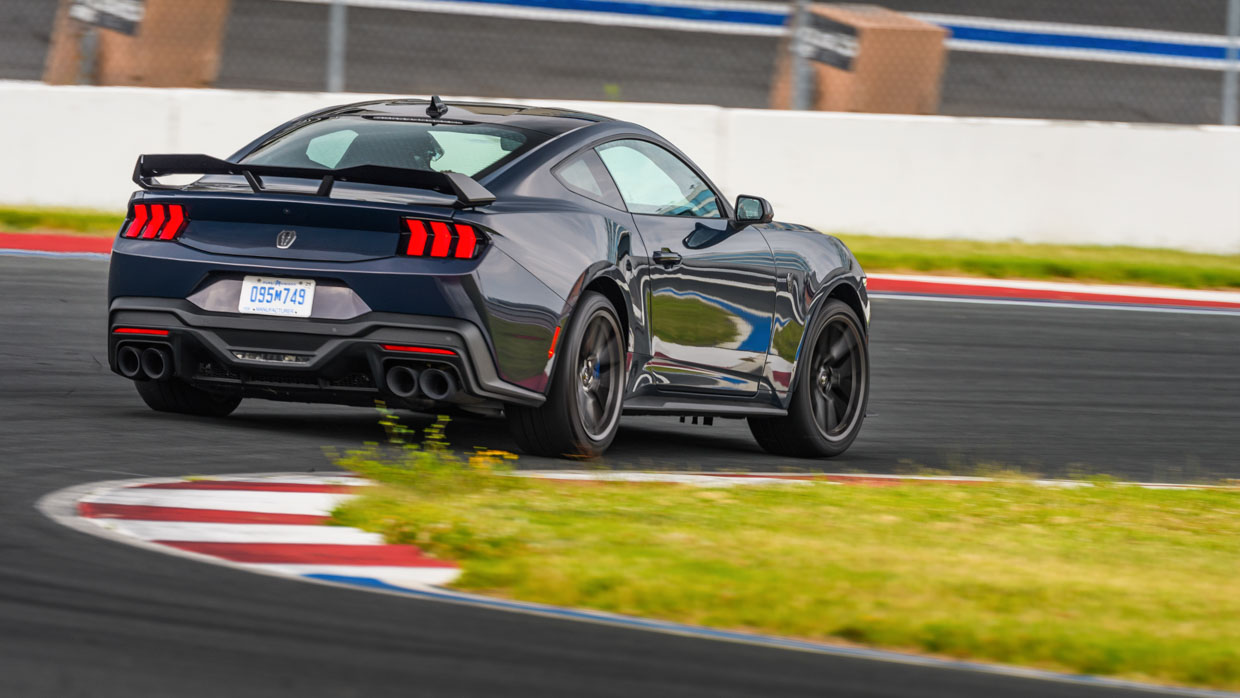
If there’s a shortcoming it’s that the auto can feel unresponsive to downshift, though much of this is down to the engine revving so freely and reaches its lofty 7500rpm redline so eagerly that the driveline simply allows over-revving under braking.
Ford swears it’s as quick on track as the manual, and perhaps so given more seat time to synchronise the transmissions ratios to the road speed more naturally and intuitively.
The regular Dark Horse, as hot a showroom version as will be offered in Oz and sampled on track as a manual, has noticeably less roadholding grip. But it’s no less fun because of it.
It breaks lateral friction much more easily, demands more patience with steering, braking and the right foot, but seems to lack none of the superb balance and cooperation of the Handling Package version whatsoever.
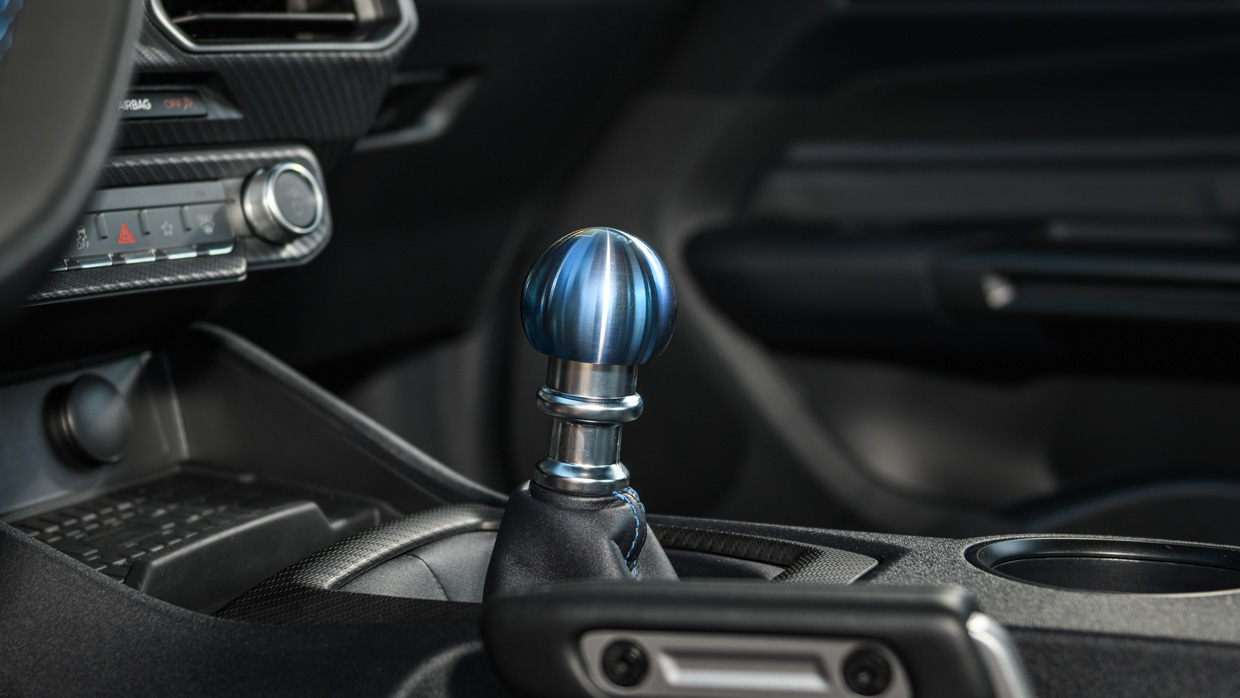
Really cool and handy is its flat-shifting function: above 5000rpm and with more than 90 percent throttle, you can pin the right foot during upshifts and the engine control module cuts spark to prevent over-revving.
It’s particularly handy upshifting to fifth on the turn two bank approaching 200km/h to not unsettle the chassis and send you into the concrete barriers on a speedway oval…
The manual is, in your reviewer’s opinion, a far better on-track choice. It feels taut, positive and robust, the ratios well-judged and closely stacked, and there’s enough linear torque from the V8 that you can hold third and fourth even in the tight and twisty corners and get stellar corner exit drive without rowing the gearstick excessively.
On track, the regular chassis probably deserves a proper R-spec tyre to keep up with the capability of the rest of the package and offer staying power when these road-spec tyres start giving up the ghost earlier than you ideally like.
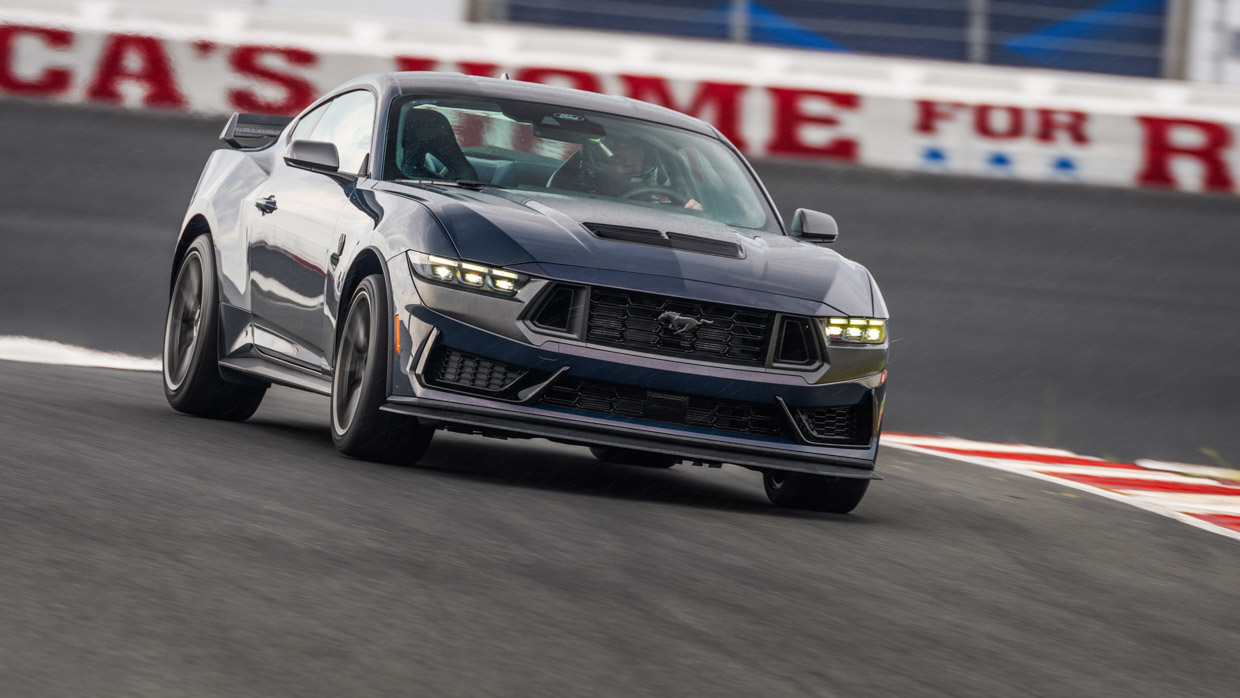
Dialing down the heat is a good opportunity to unpack the new seventh-gen interior, at least in outlandish Dark Horse spec, which will be offered with regular pews or cost-optional form-hugging Recaros.
At its core, the new Mustang is a little more modern, with a fresher design that ditches a lot of the sixth generation’s retro kitsch, if without diluting too much of the old-school muscle car aura minted in its DNA that dates back to the 1960s. Material or features wise, you won’t mistake it for an electric BMW, say…
Pride of place is the curved – or, more accurately, waved – dual-screen display that robs from Euro design ethos without actually plagiarising it. Where the gen-six countersunk its driver’s screen into a classic binnacle, the new screen floats, with the 12.4-inch driver’s screen and 13.2-inch media screen appearing to melt together if you choose to configure it so.
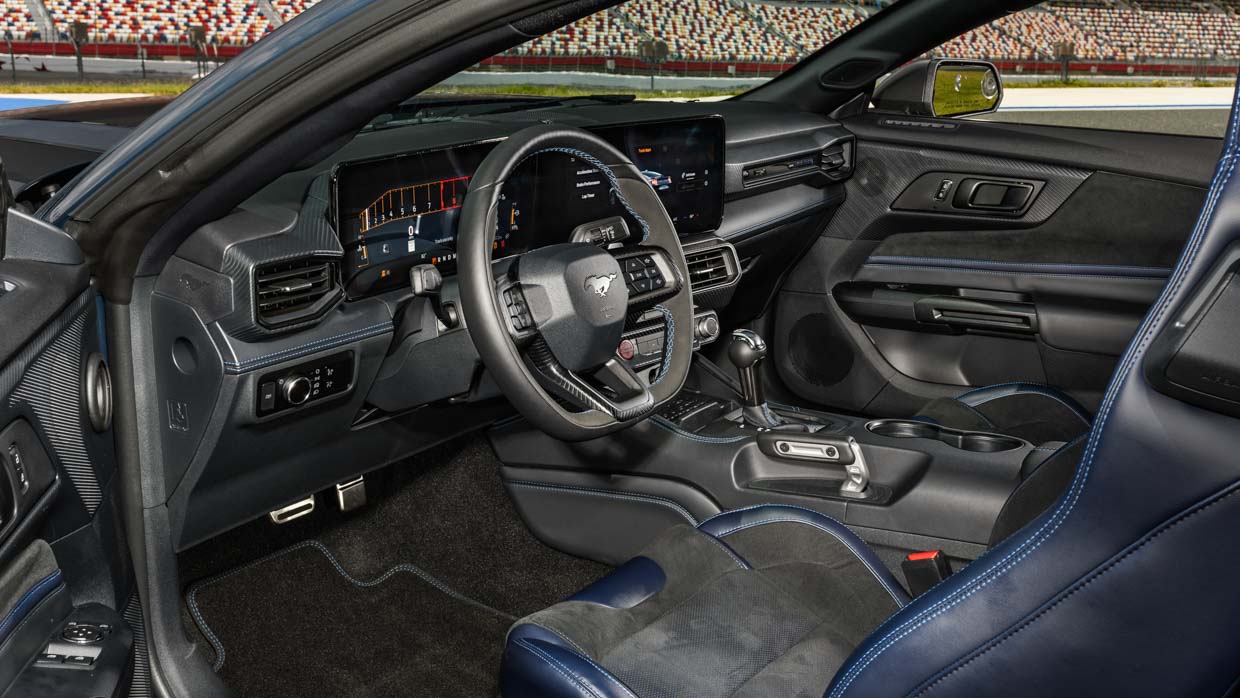
The media is Ford’s Sync 4 design and here it bundles the climate and audio control into the screen, rather than with dedicated physical controls in the centre stack.
Ford claims the move was a response to customer demand, even old-school Mustang traditionalists, though like design of this type it’s clumsy and distracting. We miss the neat jet fighter-style flick switches, too, now absent in this generation.
The level of in-built go-fast displays, driving feature adjustment and gismos is bewildering. For a muscle car, there’s a lot to meddle with and get your head around, and not all for the better.
Just figuring out what various modes you’re in and affecting tweaks to taste – like figuring out if stability control is loose or complete off – takes some learning and acclimatisation.
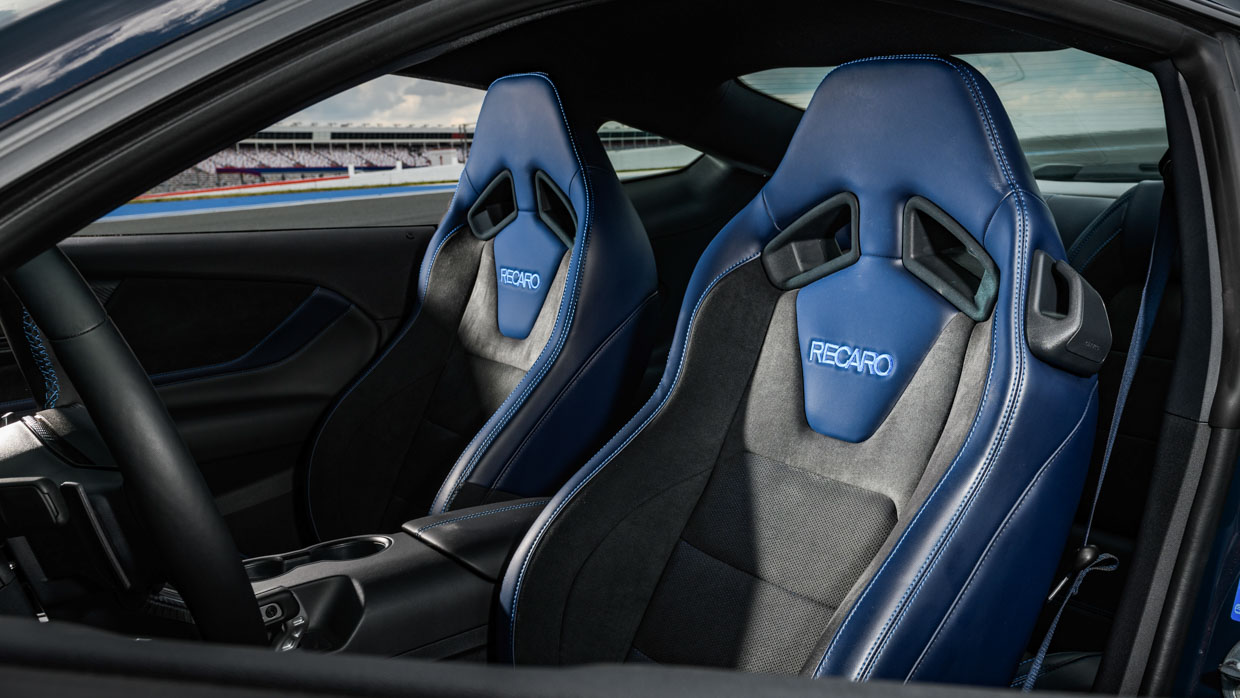
The standard front buckets are a decent improvement over the older pews. They’re squishy yet reasonably supportive, but probably lack a little long-term comfort. The Recaro alternatives, which Ford Oz says will likely be offered as a standalone option, are the better choice, both for track and for grand touring.
Either choice is trimmed in cloth and leatherette and you get blue accents regardless of the exterior paint choice, though even the red-bodied versions – seventh-gen’s most fetching hew in your reviewer’s opinion – don’t look too strange with the blue cabin flourishes.
There’s little broken nor fixed with the low-slung seating, the high bonnet line that slopes away in the forward view and reasonable if unmarkable outward visibility that’s a by-product of the muscle car vibe the Mustang full embodied.
The flat-bottom wheel has oodles of reach and tilt adjustment, the manual’s lovely titanium shifter falls neatly to hand and the pedals are set up nice and flat.
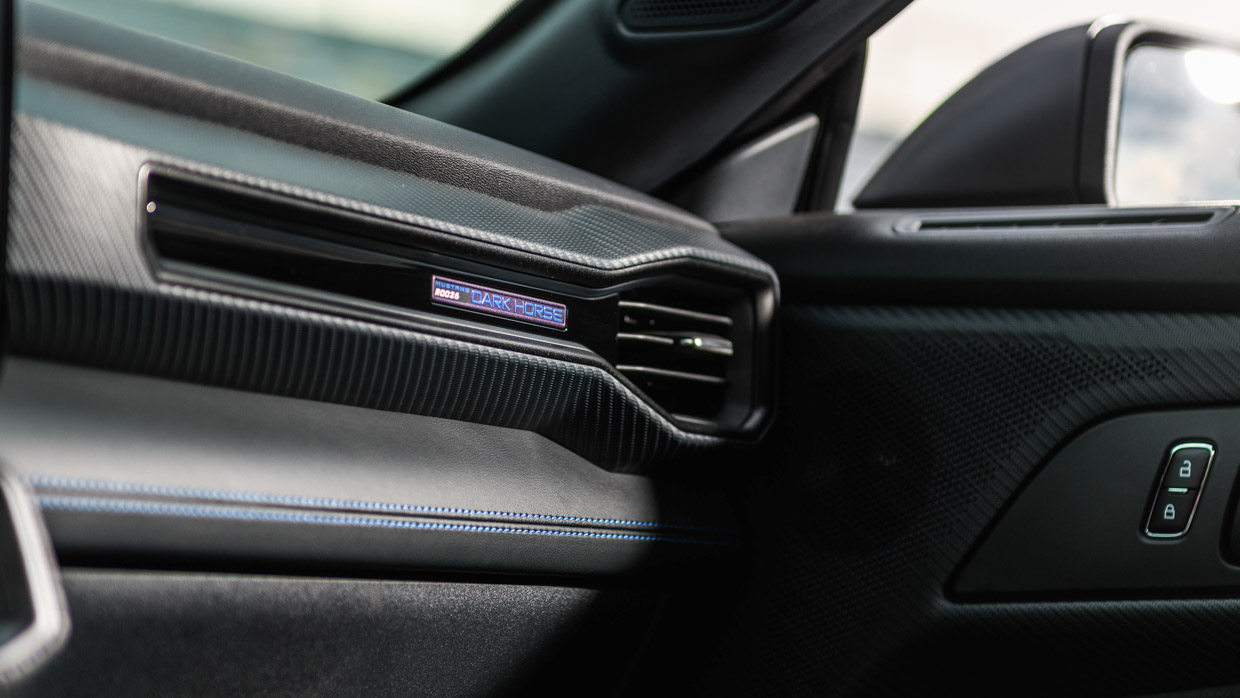
Rear accommodation is, like its forebear, little more than a token gesture and the coupe version remains best considered a two-seater plus and emergency backup for a third passenger at an absolute pinch.
Further, the mechanical flip front seats don’t offer much entry and egress clearance into row two beyond squeezing a backpack or bag through to place on the rear bench.
For its track prowess and alpha muscle vibes, the new Mustang’s road manners are surprisingly polite given the toughened Dark Horse spec…at least in regular, bound-for-Oz spec. We sample that version over three days and around 600 kilometres of road tripping, but also the harder-still Handling Pack for a 100-kilometre country road.
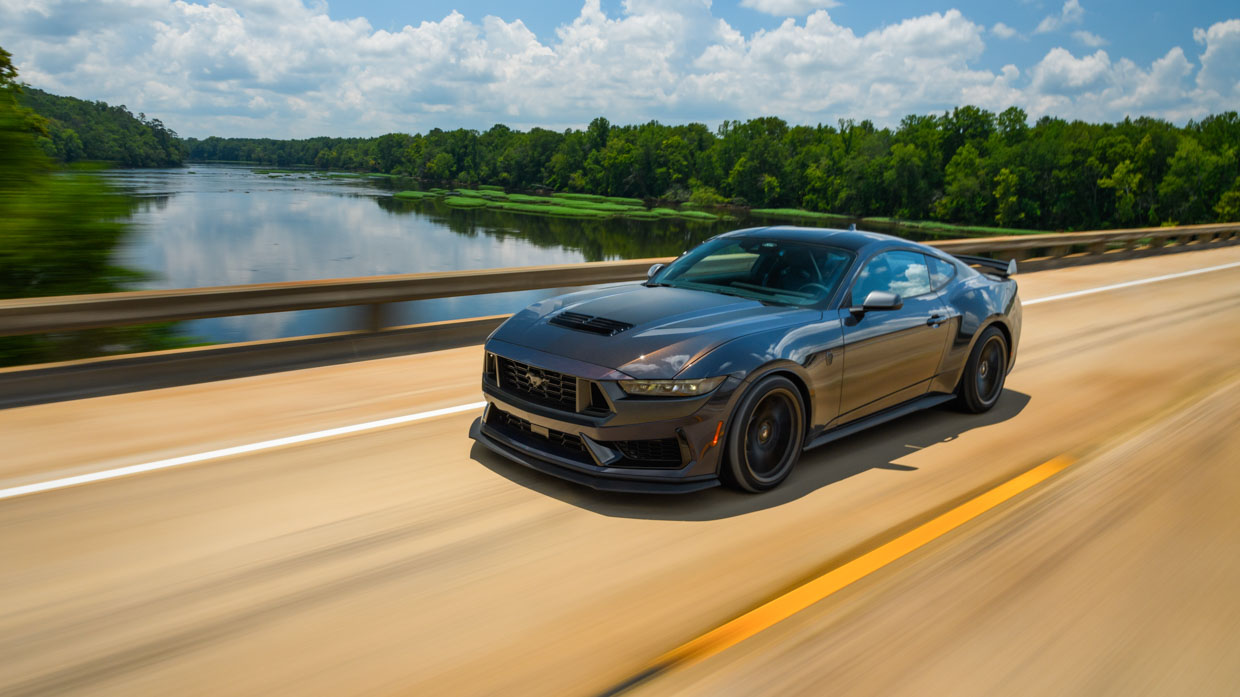
The latter is also surprisingly friendly for what it is: a track weapon four grades harder-core than the regular V8 GT.
Ride is acceptable (at best), it’s flexible in nature and not all that fatiguing during our three-hour tour of mostly nicely polished North Carolina b-roads. But hit a sharp-edged road imperfection or pothole and, jeez, do you know it.
Then there are the Pirelli Trofeo RS tyres, a huge 305mm front and 315mm rear combination that tug and tramline so much across imperfect road surfaces that you’re constantly chasing steering adjustment to track straight. Again, nature of a particularly fearsome beast.
But the regular Dark Horse, on 255mm and 285mm summer road tyres with one-rung-milder spring rates, is vastly more natural and comfortable on road. Yes, the softest ‘normal’ ride is firm, but not nearly as much as you’d expect for a chassis so planted and focussed.
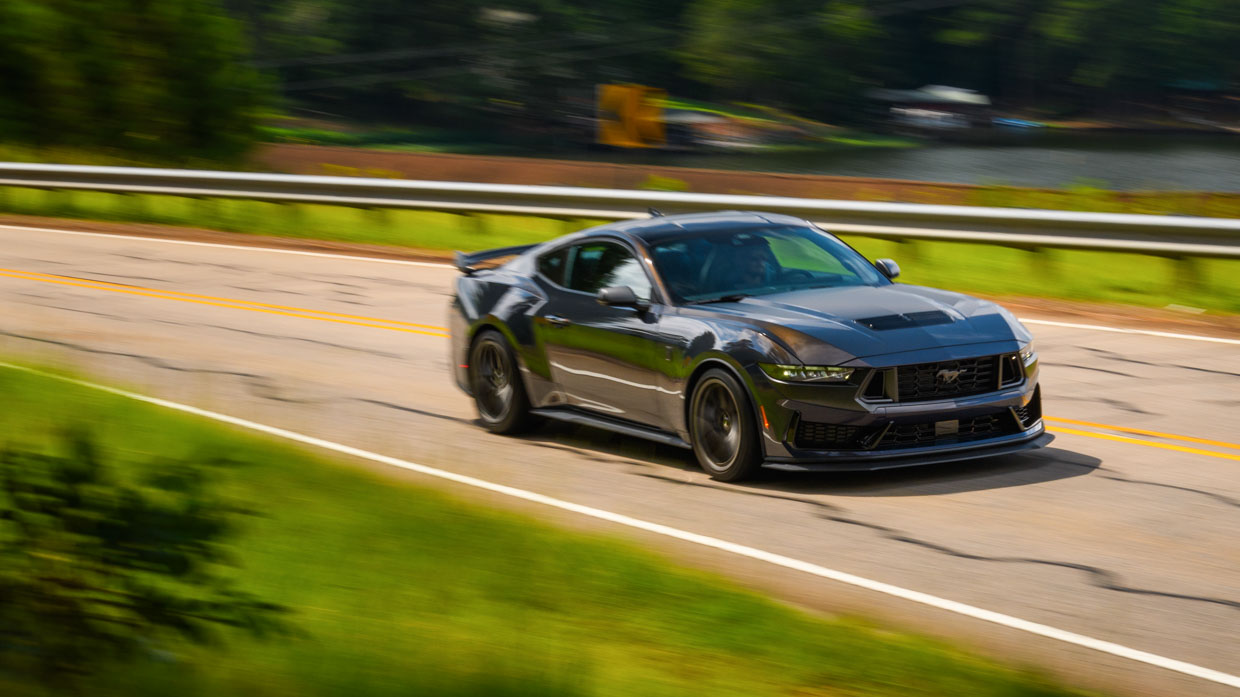
It’s only when we get to our destination, after around 500kms or open road touring, and sample our manual example across the downtown cobblestones of Richmond, Virginia, that the ride becomes a bit unpleasant. That said, given how this machine is pitched, the ride and handling balance is remarkably good.
The new Dark Horse is nicer and easier to drive than the outgoing V8 GT. Simple as that. It’s more direct in its driver connection and more evenly tempered across the on-road breadth of commuting and touring.
On the highway, dialled up to around 130km/h with the local traffic flow, it sits planted and rides the undulations with fine compliance. And when any curves arrive, it grips up tenaciously and sits obediently without any fidgety tramlining or unruly behaviour.
It really is the sharpest your reviewer has ever driven, though not scalpel like as you might find in, say, a Porsche Cayman. But handling is tenacious and the steering is pinpoint accurate, with a tail that really plants itself and shows little signs of sudden wayward looseness.
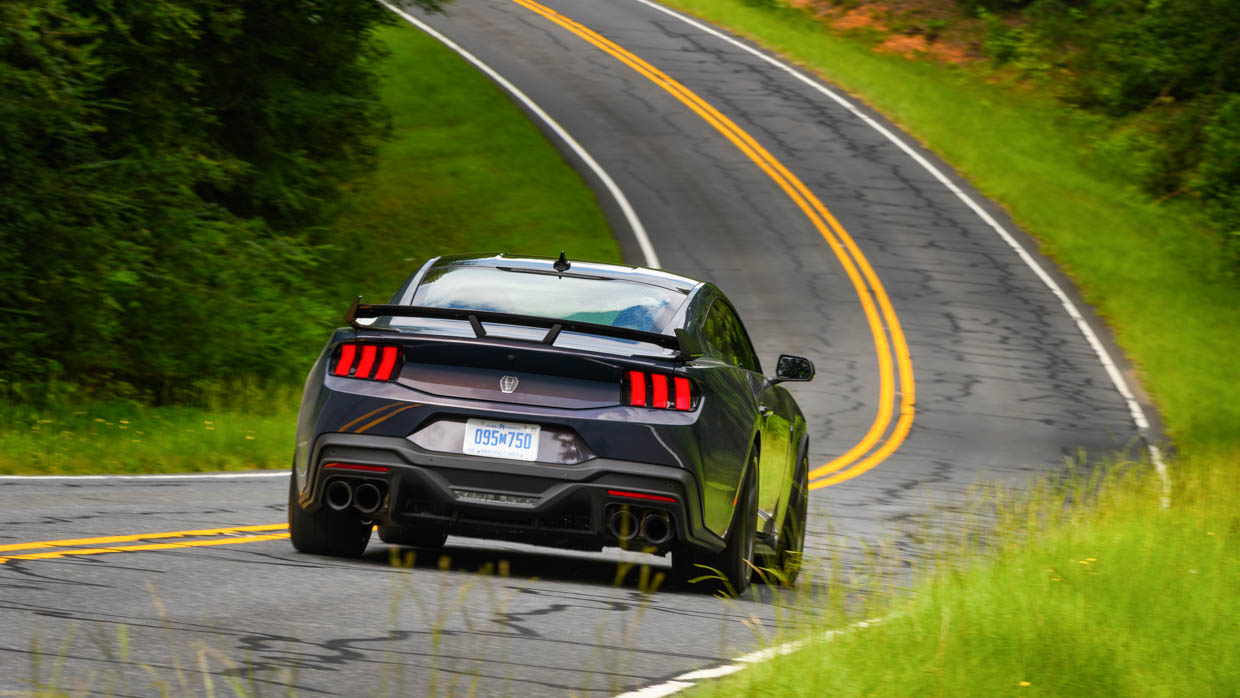
It’ll carry a serious head of steam, as demonstrated across the wonderful Blue Ridge Parkway touring road in the Appalachian mountains, with a chassis more than capable of harnessing all 373kW, married with brakes that do feel, at times, almost overly powerful for the tasks at hand.
The engine, for all of its stonk, still demands a downshift to tap its fulsome energy, such is the conventional nature of the 5.0-litre naturally aspirated V8 nature despite its old-school 500-horsepower stonk.
But the closely-stacked Tremec gearbox – with only sixth in overdrive – is a handy ally and, like on track, the better fit for accessing the engine’s sweeter spots in the rpm range.
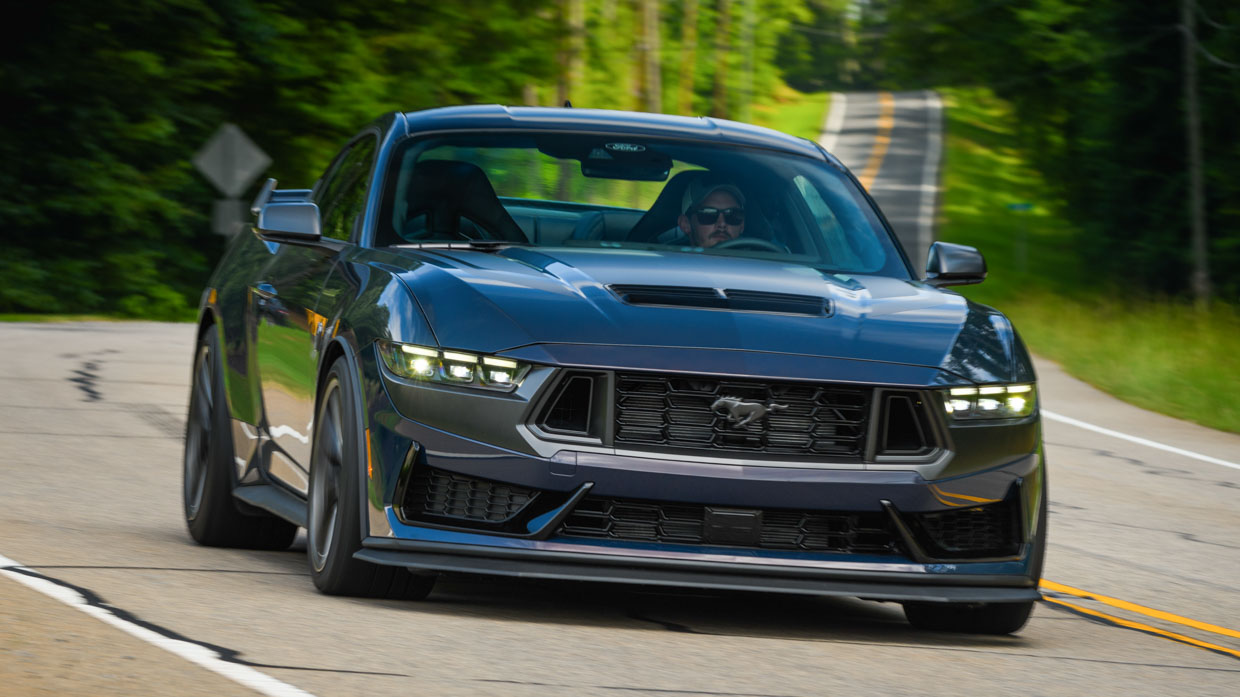
If the Dark Horse is anything to go by, the regular V8 GT ought to be a cracker. That’s because this limited-edition hard-core version is both measurably more potent and quicker than the old GT…and a more satisfying thing to tool around in when you heat back.
Ford has a great job with this particular package. One that will nudge six figures landed in Oz if a version special enough in vibe and unique enough in spec to warranty the enthusiast-centric price tag.
What’s obvious is that Ford has continued to carve a proper gearhead machine, and one that offers enough key specification change as you walk up the range that its gearhead appeal is no fluke.
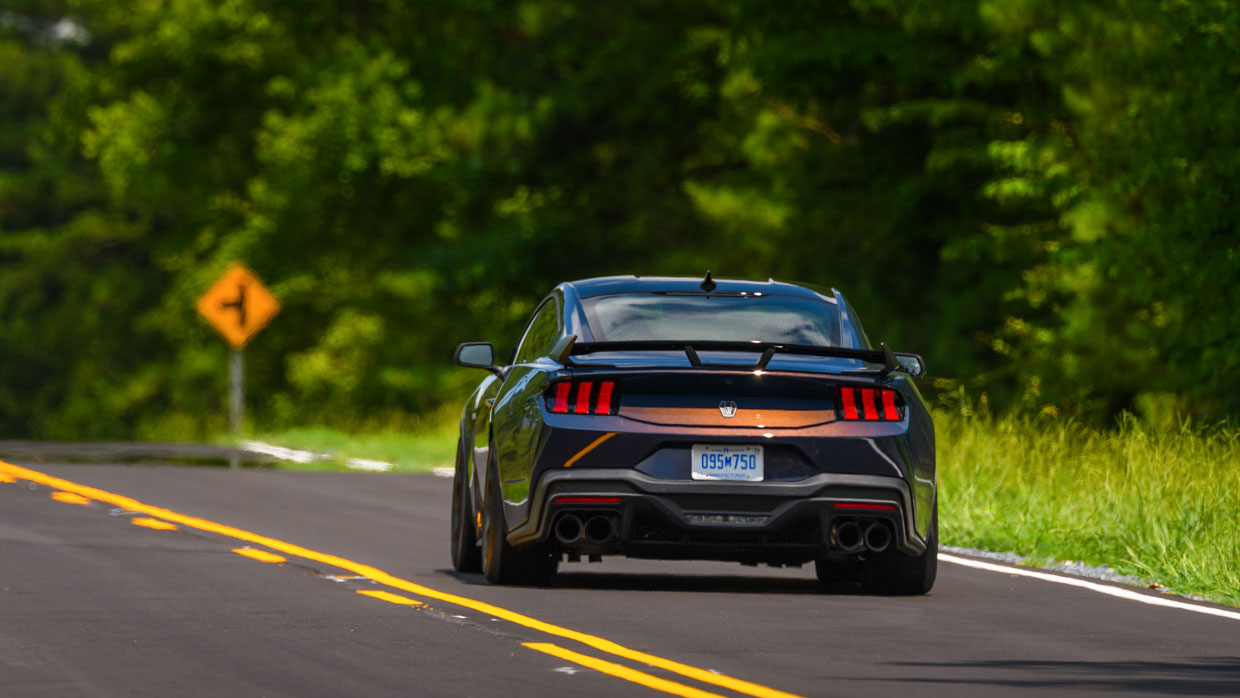
If the Dark Horse lands in Oz in mostly the same guise, it deserves to be as popular with enthusiasts with traditional tastes as the sixth-generation has been to this day – that Ford Australia had to pause order on a decade-old example due to popularity overrunning supply is quite remarkable.
Dearborn says that its new special edition is also limited, if without specifying by number or production duration. But even with open-ended production and supply, the Dark Horse might prove hard to get hold of when it arrives Q1 next year.
It certainly seems to have enough of the right stuff to justify the potentially red-hot demand.
About Chasing cars
Chasing Cars reviews are 100% independent.
Because we are powered by Budget Direct Insurance, we don’t receive advertising or sales revenue from car manufacturers.
We’re truly independent – giving you Australia’s best car reviews.
The estimate provided does not take into account your personal circumstances but is intended to give a general indication of the cost of insurance, in order to obtain a complete quote, please visit www.budgetdirect.com.au. Estimate includes 15%^ online discount.
^Conditions Apply
Budget Direct Insurance arranged by Auto & General Services Pty Ltd ACN 003 617 909(AGS) AFSL 241 411, for and on behalf of the insurer, Auto & General Insurance Company Limited(ABN 42 111 586 353, AFSL 285 571).Because we don’t know your financial needs, we can’t advise you if this insurance will suit you. You should consider your needs and the Product Disclosure Statement before making a decision to buy insurance. Terms and conditions apply.
Indicative quote based on assumptions including postcode , 40 year old male with no offences, licence suspensions or claims in the last 5 years, a NCD Rating 1 and no younger drivers listed. White car, driven up to 10,000kms a year, unfinanced, with no modifications, factory options and/or non-standard accessories, private use only and garaged at night.
^Online Discounts Terms & Conditions
1. Discounts apply to the premium paid for a new Budget Direct Gold Comprehensive Car Insurance, Third Party Property Only or Third Party Property, Fire & Theft Insurance policy initiated online on or after 29 March 2017. Discounts do not apply to optional Roadside Assistance.
2. Discounts do not apply to any renewal offer of insurance.
3. Discounts only apply to the insurance portion of the premium. Discounts are applied before government charges, taxes, levies and fees, including instalment processing fees (as applicable). The full extent of discounts may therefore be impacted.
4. We reserve the right to change the offer without notice.